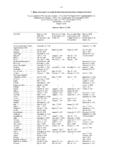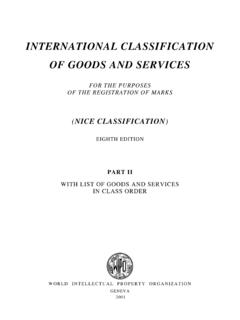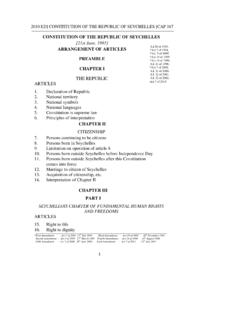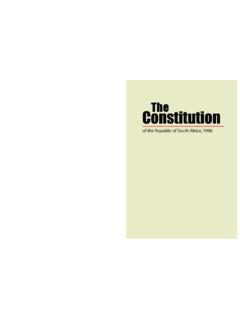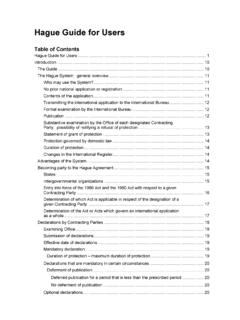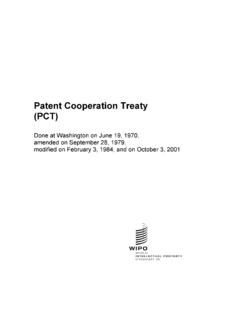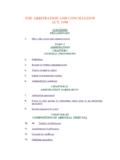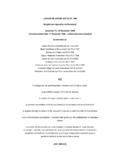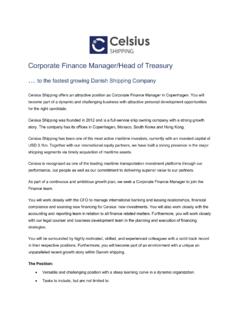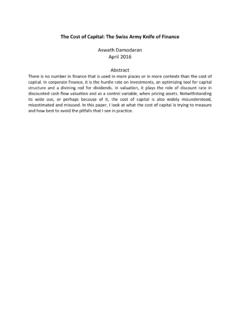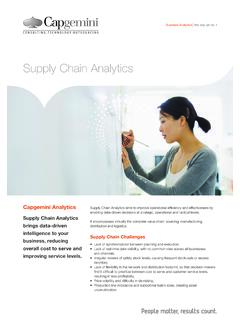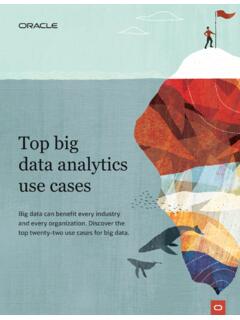Transcription of MODULE 11 IP Valuation - WIPO
1 MODULE11IP ValuationMODULE 11. IP ValuationOUTLINELEARNING POINT 1: What is IP Valuation1. Definition of an asset2. Value of an asset3. Definition of IP valuation4. IP Valuation triggersLEARNING POINT 2: IP Valuation methods1. Cost method2. Market method3. Income methodLEARNING POINT 3: Preparing for IP valuation1. IP audit in IP valuationLEARNING POINT 4: How to valuate IP assets using DCF method: Step by step1. Main concept2. Projecting income stream ( cash flow )3. Determining the Remaining Economic or Useful Life (RUL) of the IP asset4. Considering risks (Discount Rate)LEARNING OBJECTIVES1. You will understand what is meant by assets, IP assets, value and IP You will learn the reasons or the circumstances that call for the conducting of an IP You will understand the essence of and the differences between the three commonly used Valuation methods such as cost, market and income methods, including the real option You will go through each step of the discounted cash flow method (DCF).
2 LEARNING POINT 1: What is IP Valuation1. Definition of an asset An asset is a resource that is controlled by an entity (such as a company or a business) as a result of past events (for example, purchase or self-creation) and from which future economic benefits (inflows of cash or other assets; or reduction in costs) are expected. Basically, the wealth of a business comprises of the following types of assets Wealth = Working Capital + Fixed Asset + Intangible Assets Working Capital : Working capital refers to the excess of current assets (cash, short-term investments, accounts receivable, inventories, prepaid expenses, etc.) over its current liabilities (trade accounts payable, current portion of long-term debt, income taxes, withholding taxes, accrued liabilities, etc.). It is also known as net current assets. Fixed Asset : Fixed assets which include plant, machinery and equipment, land and buildings, office furniture and equipment, computers, vehicles and other tangible property used by a business but not converted into cash in day-to-day business.
3 Traditionally, fixed assets were considered to be the brick and mortar of a business and were seen as the main contributors to its wealth/value. Intangible Assets : Intangible assets are the non-physical property of a business. Traditionally, they were considered to be the 'Goodwill' of a business, that is, the amount paid for a business in excess of the fair value of its identifiable net assets. A wide range of intangible assets, such as customer's loyalty, well respected business name/strong reputation, calibre and morale of employees, IP assets, etc, were clubbed under 'Goodwill.' Intellectual property (IP) assets? IP assets are a sub-set of intangible assets and distinguished from other intangible assets by the fact that these are created by law. As such, IP assets are legally protected and can be legally enforced. These can be independently identified, are transferable and have an economic life (in contrast to their legal life, which is generally longer than their economic life).
4 IP assets include patents, industrial designs, trademarks, copyright and trade secrets. Legal perspective: An IP asset can be defined in terms of particular qualitative characteristics or standards (such as that of novelty, originality). Economic perspective: An IP asset can be defined in terms of the economic benefit linked to the IP asset. For example, a patent that has not contributed to the production or protection of income, has no economic value, even though it has legal existence. 2. Value of an asset The value of an asset is the value of the future economic benefits it brings. The value of an asset, whether tangible or intangible, can be estimated. Some assets are easier to value than others, and some valuations are more precise than others. Monetary or financial Valuation is the process of determining or measuring reliably the value or worth of an asset in certain circumstances, the cost or price of an asset may be a good indicator of its value.
5 (1) Value of an IP asset? The value of an IP asset derives, in essence, from its ability to exclude competitors from a particular market. Whilst the legal right grants exclusivity or the right to exclude, the economic right is based on exclusivity of use, that is, the ability to control the use of the IP asset. For an IP asset to have a quantifiable value, it should: - generate measurable amount of economic benefit to its owner/user. - enhance the value of other assets with which it is associated. (2) How to derive value from an IP exploitation of the sale or licensing of the by not exploiting an IP asset ( , by merely owning it), it may be possible to add value, for example, by: - minimizing the negotiating power of customers, - offsetting supplier power, - mitigating rivalry, - raising barriers to entry by competitors, - reducing the threat of More: Price and ValuePriceThe price of an IP asset represents the amount of money for which the ownership of that IP asset would be exchanged between a willing buyer and a willing seller.
6 Price is the monetary amount at which an asset trades in the is typically defined as what a buyer is willing to pay, in an arm's-length transaction, based on his perceived value of the asset. The determination of price may be influenced by many factors, which include time, demand, reasons for selling, synergies for buyer, negotiation skills of the parties involved, etc. ValueThe value of an IP asset represents the potential future economic benefits to the IP owner or authorized example, for a purchased patent, presumably, the benefits (value) to the buyer exceed not only the price paid but also many other costs that may be incurred by the buyer in the process of buying (such as time costs and transaction costs) or in exercising the option of buying the patent (such as opportunity costs : not being able to do or buy something else if the patent is purchased).
7 3. Definition of IP Valuation IP Valuation is a process to determine the monetary value of subject IP. (1) Prerequisites for Undertaking IP Valuation To be able to do the Valuation of an IP asset, it must be separately identifiable. IP asset must be subject to specific identification and a recognizable description. should be some tangible evidence or manifestation of the existence of the IP asset ( , a contract, a license, a registration document, a computer diskette, a set of procedural documentation, a listing of customers, recorded on a set of financial statements, etc.) should have been created or have come into existence at an identifiable time (or time period) or as the result of an identifiable event. should be capable of being legally enforced and legally transferred.
8 Should be capable of having its income stream separately identifiable and isolated from the contribution of other assets employed in the business. should be capable of being sold, without selling the other business assets of the enterprise to the same buyer. should be subject to being destroyed or to a termination of existence at an identifiable time (or time period) or as the result of an identifiable event. (2) Factors influencing IP Valuation a. Premise of value : The value of an IP asset would depend on the context or circumstances in which it is being valued. For example, is it being valued in the context of a 'going concern' where it is 'alive and well' and performing its job, or is it being valued in a context of a going concern but where it is not being used? Similarly, in the case of liquidation, is it a forced liquidation or an orderly disposition of assets?
9 The value will be different in each of these four situations. b. Standard of value: Learn More c. Reasons for, or purpose of, the Valuation d. Time or date of Valuation e. Access to and reliability of relevant data and information f. Valuation method(s) applied and assumptions made while applying a Learn More: Standard of valueUnderstanding the concepts of fair market value and fair value, the most commonly used standards of value, is important when undertaking an IP Valuation exercise. Fair market value (Market value)Fair market value can be defined as the price at which an asset or service passes from a willing seller to a willing buyer. - Premise of value : ExchangeIt is assumed that both buyer and seller are rational and have a reasonable knowledge of relevant facts. Fair value (Fair price)Fair value is seen as appropriate for use in post transaction purchase price allocation.
10 - Premise of value : UseFair value is based on the assumptions that market participants would use when pricing the asset. Whereas fair market value is seems to be more appropriate when used in the premise of value in exchange, fair value is often based on premise of value in-use. In common situation, IP Valuation is a process to valuate the fair market value of an IP Valuation method g. Legal, tax, financial, or other business circumstances h. Nature, scope and strength/validity of the underlying IP asset I. infringement or freedom to operate issues 4. IP Valuation triggers There are numerous individual reasons or motivations for conducting an IP Valuation . The Valuation triggers refers to the reason or purpose of the Valuation . These include the following:More References 1 1: IP Valuation Trigger1. Transaction 1) Licensing of IP assets; franchisingBefore conducting negotiations for licensing-in or licensing-out of IP, a thorough understanding of the value of the IP assets ensures more informed negotiation and decision-making concerning the terms and conditions of the proposed license, especially in determining fair and robust royalty rates for optimal exploitation of the IP asset.
